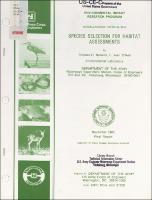Please use this identifier to cite or link to this item:
https://hdl.handle.net/11681/22148Full metadata record
| DC Field | Value | Language |
|---|---|---|
| dc.contributor.author | Roberts, Thomas H. | - |
| dc.contributor.author | O'Neil, L. Jean | - |
| dc.date.accessioned | 2017-04-19T16:42:53Z | - |
| dc.date.available | 2017-04-19T16:42:53Z | - |
| dc.date.issued | 1985-11 | - |
| dc.identifier.uri | http://hdl.handle.net/11681/22148 | - |
| dc.description.abstract | Abstract: At the center of a Habitat Evaluation Procedures (HEP) analysis is a determination of habitat quality for a set of species based on Habitat Suitability Index models. Because the measure of quality used in the HEP accounting framework usually is based on a small number of species, selection of the proper evaluation species is a. critical step in planning an analysis. HEP is not intended to be a rigid, mechanistic, or exact process that provides a totally objective "right answer" concerning the consequences of land use changes. HEP is a flexible tool for planning and management and a means of quantifying fish and wildlife considerations and of displaying findings and professional judgments. As such, HEP must be "guided" to achieve results that accurately reflect potential impacts. Study objectives and criteria that define quality or value of fish and wildlife resources (e.g., uniqueness, relative abundance, local and regional significance, sensitivity to change, replaceability, etc.) must be determined for each project and used as a basis for selecting evaluation species. The subjective decisions involved should be well documented and displayed along with the rest of the HEP analysis. A species may be selected because of its own importance (economic value, management or public interest, ecological role) or because it represents a cover type or other species in the community that use the same resources. Use of species to represent a plant community or cover type is clouded by the fact that different species use resources in different ways; curves for variables held in common by two species may be significantly different, leading to inadequate, contradictory, or misleading results. If one species is used to represent another, variables in both models should be examined closely to ensure that all major components of the target species' habitat will be evaluated. Guild theory provides a means of extrapolating results from one species to others when a broad ecological assessment perspective is desired. The authors favor a guild matrix based on layers of vegetation plus other significant habitat features. Similarity of resource use should allow extrapolation of results to associated guild members, although the relationships are not always as direct as one would like. Extrapolation is improved if guild construction and species selection are done well, and if the degree of similarity among species requirements is large enough. Use of guild indicators (one or more species in a guild are chosen to represent all members of that guild) or whole guilds (all species in a guild are evaluated as a unit) are two ways in which the guild concept is applied to the species selection process. Both procedures require additional development. The notion of guiding impact studies may be difficult for some to accept given the increasingly quantitative nature of the wildlife management profession; however, human values and perceptions will always play a major role in natural .resource decision-making. It is suggested that this be acknowledged and that the concept of a totally objective study be discarded. It is the desire of the authors that some of the thoughts in this paper and those cited herein will encourage researchers to improve on guilds as a species selection tool, and will help users of HEP to be more alert to the subjectivity and professional judgment inherent in and necessary to a meaningful habitat evaluation. | en_US |
| dc.description.sponsorship | Environmental Impact Research Program (U.S.) | en_US |
| dc.language.iso | en | en_US |
| dc.publisher | Environmental Laboratory (U.S.) | en_US |
| dc.relation.ispartofseries | Miscellaneous Paper;EL-85-8 | - |
| dc.subject | Habitat (Ecology)--Evaluation | en_US |
| dc.subject | Environmental impact analysis | en_US |
| dc.subject | Animals--Habitations--Evaluation | en_US |
| dc.title | Species selection for habitat assessments | en_US |
| dc.type | Report | en_US |
| Appears in Collections: | Miscellaneous Paper | |
Files in This Item:
| File | Description | Size | Format | |
|---|---|---|---|---|
| MP EL-85-8.pdf | 6.01 MB | Adobe PDF |  View/Open |